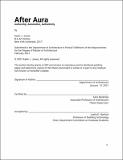After aura : authorship, automation, authenticity
Author(s)
Jones, Kailin J. (Kailin Jenifer)
Download1265046728-MIT.pdf (15.30Mb)
Alternative title
Authorship, automation, authenticity
Other Contributors
Massachusetts Institute of Technology. Department of Architecture.
Advisor
Azra Aksamija
Terms of use
Metadata
Show full item recordAbstract
Walter Benjamin wrote in his seminal 1935 essay, "that which withers in the age of mechanical reproduction is the aura of the work of art"--an essay that narrowly defines art and the craft of art up until that moment as something that is rooted in site specificity, ritual, uniqueness and non-reproducibility. This conception of art and artistic production fails to acknowledge the networks of transmission, transfer, and transformation that have always existed in parallel with the migration of objects, people and tools circulating the world throughout history. Almost a century after Benjamin's essay on mechanical reproduction, we have entered the digital, the post-digital, the automated, while at times have been nostalgic for the mechanical and the hand-made. That being said, the anxiety surrounding the Aura has in many ways not faded. We still bid wildly at auctions, flock into galleries in pursuit of the new or go on pilgrimages to architectural sites and museums to see and experience the original "in person." We also employ armies of scholars or dealers to find or authenticate the "original". In After Art, David Joselit asks for an expansion of the definition of art to "embrace heterogeneous configurations of relationships or links," freeing art from belonging to any particular time, space or medium, but rather as Pierre Huyghe says, "a dynamic chain that passes through different formats." This thesis attempts to document and utilize these dynamic chains through acts of copying using contemporary tools and conditions such as outsourcing and open sourcing. In experiments in outsourcing, I decided to digitally reproduce ornate, luxurious, objects valued for their rarity in order to make them more easily reproducible. In experiments in tools for copying, I designed a machine by utilizing an open source, anonymous, catalog of parts to imitate expired mechanical copying devices.
Description
Thesis: M. Arch., Massachusetts Institute of Technology, Department of Architecture, February, 2021 Cataloged from the official pdf of thesis. Page 124 blank Includes bibliographical references (page 123).
Date issued
2021Department
Massachusetts Institute of Technology. Department of ArchitecturePublisher
Massachusetts Institute of Technology
Keywords
Architecture.